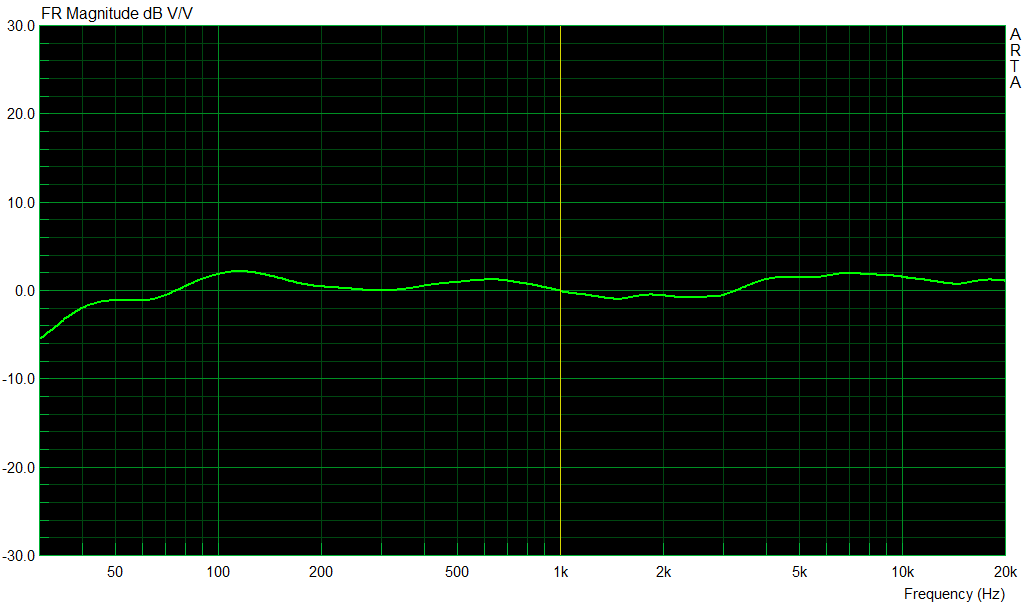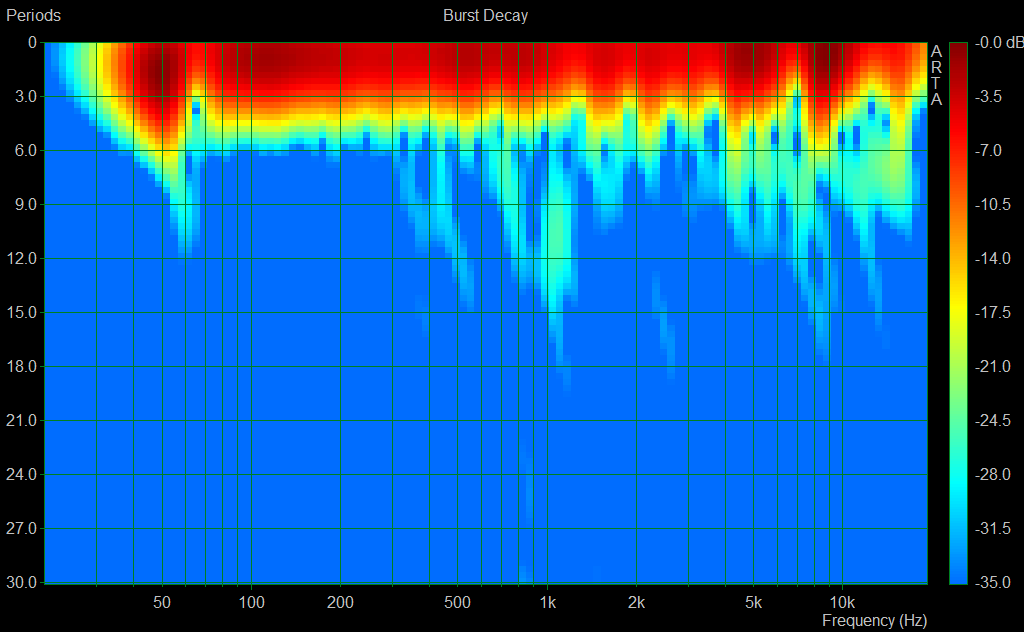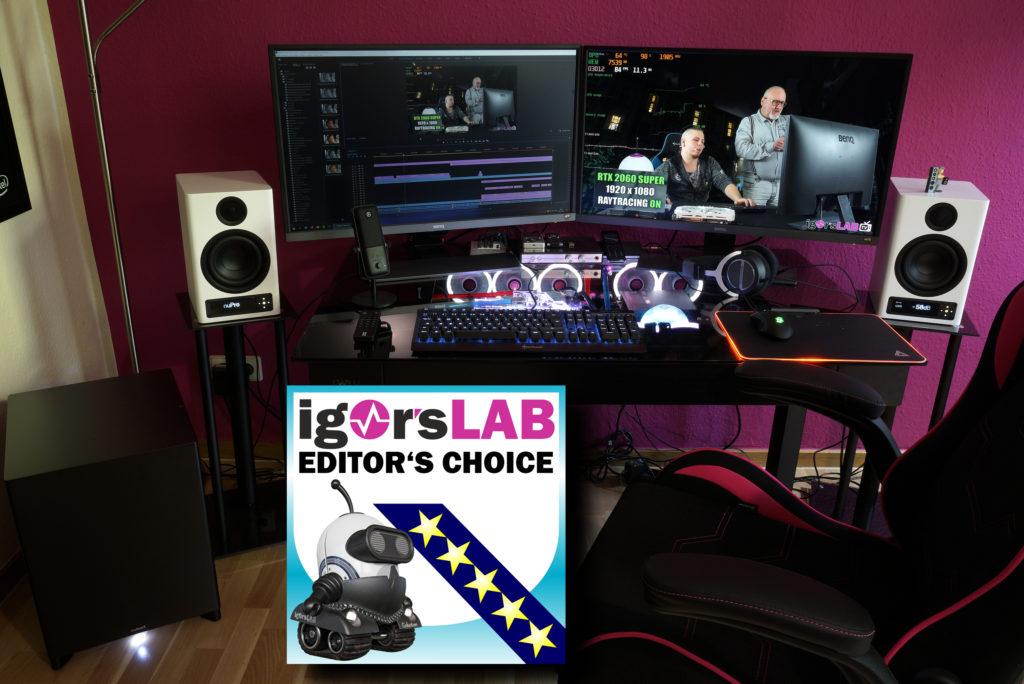And now let’s start exactly where it sometimes hurts: the hearing test. If you miss my usual measurement curves, I can reassure you, everything is in the green zone. I have measured the setup, purely for reasons of plausibility, this time only in the video recording room, because the actual measuring chamber is not usable due to larger construction works. But this video room is not really suitable for such a first-class loudspeaker.
Frequency curve
The curve is smoothed this time, because I find some not so optimal conditions in the spare room, nevertheless I do not want to withhold the measured things from you. In general, you can trust the manufacturer’s specifications of 38 Hz to 22 KHz within a tolerance range of +/- 2 dB, because that’s exactly where I ended up. If the tolerance is narrowed down further, the tolerance would be only 2 dB at 40 Hz to 20 KHz according to the manufacturer. However, I have a little trouble with some frequencies in the video room, so that the slight hills in the lower area explain themselves. This changes a little, depending on the location, but could not be completely excluded.
Cumulative spectrum: Burst decay
The cumulative spectrum refers to various types of graphs that show the time-frequency characteristics of the signal. They are generated by successive application of the Fourier transform and suitable windows to overlapping signal blocks. The following analysis is based on the frequency response diagram shown above, but additionally contains the element time. The Burst Decay Plot now shows us the corresponding result in periods (cycles). It is fair to say that the representation in periods can be more useful than the CSD with its milliseconds, e.g. to to determine the decay of a loudspeaker with a wide bandwidth.
Normally, the driver should also stop as quickly as possible after the input signal is lost. However, some frequencies (or even entire frequency ranges) will always decay slowly and then continue to appear in this diagram as longer lasting frequencies on the Y-axis. From this you can easily see where the driver may be Weaknesses, perhaps even “rattles” or where in the worst case resonances occur and could disturb the overall picture. Unfortunately, space still plays a major role here.
The picture shows very nicely the exemplary transient response and the hardly present bass resonances. The diaphragm does not resonate even in the midrange and the dome shows a very neutral behaviour. The whole high frequency range seems very present in the sum, but not pointed. In any case, there is no “trailing” here and the visible small “fringes” should be due to the premises, so the all-clear
I test the playback intentionally WITHOUT a subwoofer, which I will take a closer look at in a following review. So the two speakers have to help each other on their own and I also reset the high pass filter to 10 Hz to be as fair as possible. Although this reduces the level stability of very bass-heavy tracks just a little bit, the result is still so brutal that you rub your eyes in amazement and ask yourself how these compact speakers actually manage to produce such a fat foundation.
Bass reproduction
Test the deepest bass in the subcontraoctave (16.4 Hz to 32.7 Hz) with a recording of Bach’s Toccata and Fugue in D minor (19 and 25 Hz) and the Festival Overture 1812 by Tchaikovsky (10 Hz and 12.5 Hz). The same applies to the lower ranges of the contraoctave (32.7 to 65.4 Hz). The big bass drum (kick drum), which is a welcome companion in underground music and is usually played at about 55 to 60 Hz, this assessment is then rounded off.
The speakers even play up to the subcontraoctave, but you have to listen below 35 Hz already more closely. The contraoctave, on the other hand, is fully there and it is deep, raven black and still as crisp as freshly plucked lettuce. The burst diagram had already hinted at it: there’s nothing whimpering and whining, it’s just there and deep like Lake Constance. Now you don’t even have to reach into the verbal treasure chest to express your enthusiasm in a manner befitting your status. Fat, fatter, X-3000.
The upper bass up to 150 Hz, which also contains the great octave (65.4 to 130.8 Hz), contains the basic voice frequency of the male voice and is very important for the natural reproduction of male vocals.
This area also sounds absolutely clean and you are not accompanied by grease eyes in the upper bass, which are usually supposed to feign volume. The male vocals are sufficiently full, but still surprisingly dust-dry, the instruments are not distorted at all. This has almost something analytical about it and can be raised a bit for the cuddly fireplace scene after work is done. All in all, the resolution is far above average and allows orchestral pieces, rock, pop and jazz of all colours to perform excellently in every situation. However, the location should be chosen carefully if you want to avoid annoying modes, but then it’s not because of the speakers.
Midrange
The lower mids (also fundamental range) are around 150 to 400 Hz. Together with the already mentioned upper bass, this range plays a very important role for the subjectively felt warmth or Fullness of the sound image. The basic voice frequency of female voices can be found in this range.
Again, there is no reason for criticism, on the contrary, the boxes are almost too honest and mercilessly reveal every weakness of the players. There is no scraping or dumpling, everything remains dry as before. Female vocals can really shine and come straight to the point. The timbre of the voices and instruments is almost too neutral, but never cold or too analytical. The further course upwards is also free of any criticism. The precision is really above average and makes the system a good all-rounder for work and fun in equal measure.
The upper mids between 400 Hz to about two KHz contain a mark at one KHz, which is still used as a reference for many measurements. Unfortunately, this is also often noticeable with cheaper devices, as the manufacturers often try to overemphasize this frequency. This area also plays a not insignificant role in gaming, and a balanced reproduction contributes not insignificantly to a good spatial resolution.
The stage and the subjectively perceived quality of the spatial resolution is also here on a very high level, absolutely appropriate to the price. A large orchestra appears (purely subjectively considered) very wide in its width, very well staggered in its depth, and in total also positioned exactly enough, which makes it very easy to locate individual instruments very clearly and unambiguously at the most varied overall levels. Voice reproduction is also not affected in this area, regardless of how many sources are mixed. The suitability on the desktop is further underlined by the very good spatial reproduction in games with excellent audio material, but the speakers also get along very well in the depth of the room. The sweet spot is pleasingly wide.
High frequency range
Between two and about 3.5 KHz, the human ear is most sensitive, especially since this range of lower frequencies is responsible for the good overtone reproduction of the human voice. This frequency range is in fact decisive for the recognition of a voice or an instrument; in this context one also speaks of the respective timbre.
The reproduction is grandiosely open, neutral and builds seamlessly on the very well modelled midrange. The speech intelligibility as well as the quality of the vocals during recognition can definitely convince, even in the near field during editing. It’s also good that the active crossover is tuned in such a way that there is no audible overemphasis or any level drop here or in the further course of the frequency response. The transition between the two chassis is pleasantly flowing and above all one thing: imperceptible.
However, the loudspeakers’ own compactness gets in the way during the transition if you overdo it with the level (which is very easy to do because there are extreme reserves) and stick directly to the speakers. I would have liked the domes to be a little bit higher so that intermodulation products do not occur when you align your ears in the near field close to the monitor and the level is far above normal. But let’s be honest, hardly anybody does that anyway.
The medium heights (3.5 to six KHz) decide whether speech reproduction is successful or unsuccessful as a whole, because the S and sibilants fall into this range. The upper heights then reach up to approx. ten KHz to go to super high frequencies.
High and super high frequencies are delivered very well, even if the speakers become very agile, especially the higher it goes. Sibilants and breath sounds are however well and not exaggeratedly depicted, one can live with that very well. It never sounds too sharp or even metallic, but always remains very natural. Stringed instruments, completely independent of level, are likewise not washed forward or away, but sit exactly where they belong. This deserves almost more respect than the bass from the base. Chamber music or large orchestra in the finale Furioso, no matter – it fits like a glove.
Summary and conclusion
The parts are addictive and are almost a case for the acoustic drugs officer. Once you’re hooked, you can’t get away from it so quickly, unless you have a large-volume living room setup for rehab as a replacement. What the X-3000 delivers is great, cosmopolitan ear cinema and definitely worth the price. At 628 euros per box in direct sales, the financial bar is pretty high, but you really get something for the money.
If the long-term factor is taken into account, the parts are even cheap for the bid and the performance class. Because here too, things are much more expensive, but hardly better. If you really want to do that, there are no limits to your endeavours, of course, but then such things are not really my cup of tea. But what you get out of the rather compact nuPro X-3000 RC is really amazing and actually the reason for this quite extensive review. Because after the first test listening, I really and absolutely wanted to know what Nubert had put into it in terms of technology. Curiosity wins because it provokes.
And that’s exactly where you can really score points even in the area not visible to the normal user. Solid technology of the very finest, a harmonious power supply and a neat finish even in the corners, which you normally don’t see, justify the price in any case. The choice of components is also practical and well thought out, and durability should not be an issue. Thus, one still has a good feeling even after looking into the interior, something that really cannot be taken for granted.
In terms of sound, the balancing act between analytical tool and feel-good box is quite successful. The X-3000 RC are also desire unsparing and honest, but can also be comfortable. You can store three sound profiles and in the end there is something for everyone. If you want to know it in more detail at this point, you should start again on page one, because really everything has been said. Nothing more can be added to this and I enjoy a round of Ludwig Güttler. Because Bach trumpets work too.




































Kommentieren